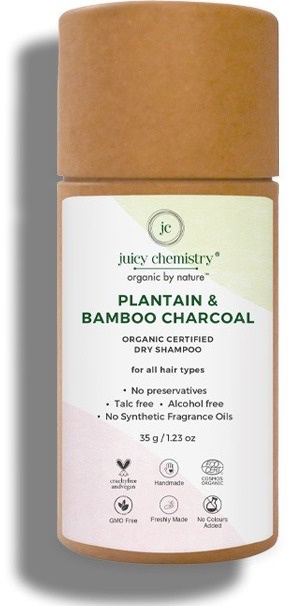
Plantain, Bamboo And Charcoal Dry Shampoo
Ingredients overview
Highlights
Key Ingredients
Skim through
juicy chemistry Plantain, Bamboo And Charcoal Dry ShampooIngredients explained

When it comes to oil-absorbing clay masks, bentonite will probably be one of the first ingredients on the INCI list. Technically bentonite clay is mostly montmorillonite + something else, and thanks to the something else bit, bentonite comes in different types and colors.
The color depends on the mineral content of the clay: white bentonite is rich in boron and fluoride, yellow is rich in manganese and zinc, green is rich in copper, zinc, and manganese and the pink clay is rich in boron.
No matter the color, bentonite is excellent at absorbing things: it can suck up the sebum and gunk from the skin and make it instantly smooth and matte. Not only that, but bentonite has a negative ionic charge and thus can attract things with a positive charge. Things with a positive charge include bad bacteria and toxins and bentonite clay masks can help to clear those out of the skin and pores (btw, bentonite is edible and has the same detoxifying effect internally).
Thanks to bentonite's effect against bad bacteria and pathogens, there is also some research showing that bentonite can help to calm skin infections, soothe skin allergies and might work for skin conditions like psoriasis and eczema.
On the other hand, the downside of bentonite being such a good absorbent is that it can suck up more than the excess sebum and used too often, it can easily dry out the skin. So use it for good measure, and never forget to moisturize afterwards.

A soft, white powder that can be used as a talc replacement in body powders or in pressed powders. It also has some oil absorbing properties and gives increased cushion and richness to emulsion-type formulas.
The plant extract coming from the leaves of English plantain or narrowleaf plantain that's native to Europe and Asia. The plant has plenty of traditional medicinal uses. Regarding the leaf and the skin, it's used to promote maturation of abscess and to speed up the recovery of incisions, pimples or wounds.
Modern studies do confirm that the plant, and specifically the leaves are loaded with active compounds that give the extract anti-inflammatory, antibacterial, and antioxidant magic properties. An in-vitro (made on chicken membrane, not on real people) study in Phytotherapy Research found that Plantain Leaf Extract in large concentrations has a comparable soothing effect to anti-inflammatory big shot, hydrocortisone.
Another study in the Journal of Herbal Medicine examined the antioxidant properties of the plant and found that the leaf extract has potent antioxidant activity (thanks to its flavonoids and hydroxycinnamic acids content) that's comparable or superior to multiple herbs and Chinese medicinal plants.
All in all, definitely a goodie plant extract that's good to spot on the ingredient list.


This ingredient name is not according to the INCI-standard. :( What, why?!
The essential oil coming from the sweet orange. In the case of orange (and citruses in general), the essential oil is mainly in the peel of the fruit, so it's pretty much the same as the orange peel oil (also has the same CAS number - a unique ID assigned to chemicals).
Its main component is limonene (up to 97%), a super common fragrant ingredient that makes everything smell nice (but counts as a frequent skin sensitizer).



The essential oil coming from the peel of the pink grapefruit. In general, the main component of citrus peel oils is limonene (around 90% for grapefruit peel), a super common fragrant ingredient that makes everything smell nice (but counts as a frequent skin sensitizer). Similar to other essential oils, grapefruit peel has also antibacterial and antifungal acitivity.
Other than that, citrus peels contain the problematic compounds called furanocoumarins that make them (mildly) phototoxic. So be careful with grapefruit peel oil, especially if it's in a product for daytime use.
The fragrant essential oil coming from the whole plant of Rose Geranium. It has a lovely scent with a mix of rose and citrus.
Like most essential oils, it contains antioxidant and antimicrobial components, but the main ones are fragrant constituents (like geraniol and citronellol). Be careful with it, if your skin is sensitive.
You may also want to take a look at...
| what‑it‑does | viscosity controlling |
| irritancy, com. | 0, 0 |
| what‑it‑does | viscosity controlling |
| what‑it‑does | soothing | antioxidant | antimicrobial/antibacterial |
| what‑it‑does | abrasive/scrub |
| what‑it‑does | abrasive/scrub | buffering |
| what‑it‑does | perfuming |
| what‑it‑does | abrasive/scrub |
| what‑it‑does | surfactant/cleansing | perfuming |
| what‑it‑does | perfuming |
| what‑it‑does | perfuming |






